ETX TECHNICAL TIPS
Last updated: 31 August 2001
ETX TECHNICAL TIPS |
After many hours of working with the ETX 60 and enjoying the viewing experience, it became obvious that the 6 AA batteries were not lasting as long as I had hoped. Rechargeable AA batteries, were a better option, but offer even fewer hours of viewing than alkaline batteries.
I wanted an external power supply solution that would not modify the ETX 60 and void the remaining months of warranty on the scope. Another objective was to maintain the portability of the scope and not be confined to an AC adapter. Looking through the current Radio Shack catalog I found a portable DC Power Station (#61-2801) capable of supplying 1.5V, 3.0V, 4.5V, 6.0V, 9.0V and 12VDC at 7 AH. Since it was capable of many output voltages, the Power Station could be used for many applications, including a larger scope.
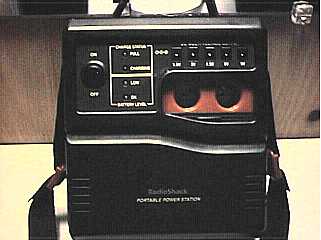
There were several concerns with an external supply, the primary being not to stress the internal wires of the scope, which are short and if pulled could break the connections in the scope. Second, avoiding electrical short circuits resulting in damage to either the scope or the external power source.
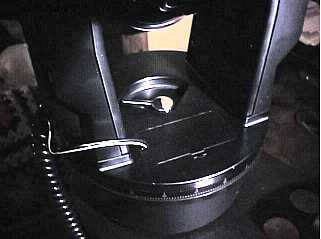
The solution was to use a 4 AA battery holder (#270-383) with a 9V snap connector from Radio Shack. The 4 AA battery holder is smaller than the Meade supplied battery holder, but it connects to the terminals and fits into the battery compartment without stressing the internal scope connector. Soldering to the positive and negative terminals of the battery holder and routing the cable through two holes near the holder terminals. This allows easy routing of the cable out of the battery compartment.
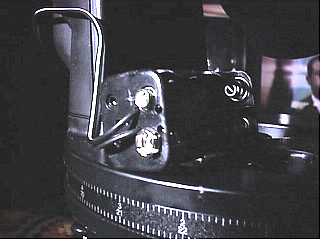
To provide additional strain relief on the battery cable, I routed the cable through the center of the coiled cable of the Autostar. In addition to providing strain relief, routing the cable through the Autostar cable helps to prevent wrapping problems while the scope is slewing.
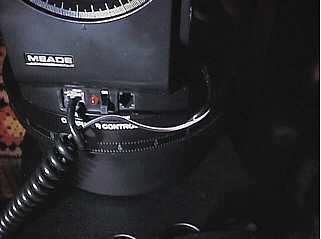
After several extended sessions using this modification, the scope performs very well with no concerns for running out of power during a session.
If you attempt this modification, please confirm polarity at the battery terminals. Incorrect wiring could result in damage to the scope.
Joe Walker
jwlk3@ix.netcom.com
Subject: Meade ETX-60 and ETX-70 AC Adapter Sent: Saturday, June 9, 2001 15:45:10 From: dhill@prairieinet.net (Dave Hill) Many people ask about converting their Meade ETX-60 or ETX-70 to run off of an AC adapter. Most of these conversations just discuss voltages. The number of AMPS that a power supply provides is just as important, possibly more so, than the voltage. Put too many amps through your scope and kiss it goodbye. To illustrate this point, consider the difference between a typical 9-volt battery and a 12-volt car battery. I would be perfectly happy running my scope off of 12 volts, it's close enough to not worry about, but I would be insane if I thought I could hook up a car battery to it. The massive amperage in a car battery would leave nothing but a smoking pile of plastic where my telescope had been. Here are my observations and measurements of the amperages used by my ETX-70 when run off of the battery pack supplied with it, as well as measurements and observations from AC adapters. Just in case you don't know, 1 amp = 1000 milliamps (1000 mA). Moving telescope on either axis with battery takes 250 mA (0.25 amps) Moving on both axes at same time with battery takes up to 450 mA (0.45 amps). Battery pack with new batteries has output of 1.4 amps when the battery back is short-circuited through the amp meter. The amperage drops very quickly when you short circuit a battery like this, this value is only meant to determine the maximum amperage that could possibly be supplied so we know what the scope can take. This means that any power supply that supplies less than this amount of amperage at the same voltage should not damage the scope. 1.4 amps is quite a bit of amperage, most common household adapters have a stated amperage that maxes out at around 500 mA, but don't trust that value, the actual voltage and amperage that these AC adapters supply is much higher! Radio Shack 9V battery eliminator AC adaptor puts out 10.5 volts with no load and 650 mA when amp meter is placed across terminals (short circuiting the battery through the amp meter). You would think then that it should easily supply the 450 mA to run the scope but motors either do not run at all or if they do run it is instantly a motor fault. Need more amperage to get the scope going. A brand new nine volt battery has output of 3.5 amps for a fraction of a second when amp meter is short circuited across terminals and then the amperage drops quickly (batteries don't like to be short circuited, don't do it for more than a few seconds). Despite the fact that the 9V battery seemed capable of supplying more amperage than the battery pack, I thought it was safe to try with the scope. I found that the scope will operate with a standard 9V battery for a while. I didn't put it to the test to determine how long it would last before draining this little battery, but one person on the web suggested that a 9V battery will work for 10 minutes. The maximum measured amperage that the scope used was 470 mA when slewing on both axes at the same time. WARNING!!! Most AC adapters supply much higher voltages and amps than they are actually rated for. For instance, a typical 9V 500mA AC adapter actually puts out 12-14v and delivers 2.5 Amps when the amp meter is placed across the terminals. From 12 volt 500 mA adapters I got 17 to 19 volts with no load and got 3.5 amps with the amp meter short-circuited across the terminals. NEVER SUBSTITUE A POWER SUPPLY FOR YOUR SCOPES BATTERY PACK WITHOUT MEASURING THE ACTUAL VOLTAGE AND AMPERAGE. If you find an AC adapter that supplies an appropriate amount of voltage and amperage, don't worry about the type of connector it has on the end. Just cut that off and replace it with a 9V battery connector available at Radio Shack. Use electrical tape on each exposed wire to keep them apart from each other and then wrap the whole splice in electrical tape for neatness and strength. YOU MUST HAVE A VOLT METER TO VERIFY THE POLARITY OF THE VOLTAGE IF YOU DO THIS. A standard 9V battery, and the battery pack supplied by Meade, have the large connector supplying negative and the small connector supplying positive. You must observe the same polarity or you will probably smoke your scope. I finally decided on using an AC adapter that was rated at 9V 500mA. It supplied 15V at no load and 1.35 amps shorted. I cut the end off of it and spliced a 9V connector on. The scope worked perfectly. Just having the electronics running brought the voltage down to 12 volts. Slewing one motor brought the voltage down to 9v, slewing both motors took the voltage down to 7.5 volts. Slewing one motor caused 260 mA of current to flow and slewing both motors caused 460 mA of current. The amperages are almost identical to battery use and the voltages are just a touch higher than the battery pack. If you want to see how a particular power supply will act without endangering your scope, we can figure out the equivalent resistance offered by the scope and you can test the AC adapter with that amount of resistance applied to it. This will call for you to buy a resistor at Radio Shack. We know that at maximum drain, the scope draws about 450 mA and has voltage across the terminals of 7.5 volts. We divide volts by amps and get 7.5 volts/0.45 amps = 16.7 ohms. If you get a resistor that is close to this value you can test the AC adapter with this resistor across the terminals. Measure the voltage across the resistor and measure the current going into the resistor. These values should be close to 7.5 volts and 450 mA. Note that the effective resistance of the scope with one motor running, 9V across the terminals, and 250 mA running through it is 9/0.25 = 36 ohms. That means you could also perform this test with something close to a 36-ohm resistor and see if you get 9V and 250 mA. Now take a look at your battery cover, there is even a notch on one side for the wires to come out so you can replace the battery cover. This is great in that it also prevents accidental pulling of the wires if you trip over the cord. So then we get down to the question of why Meade just doesn't offer a suitable AC adaptor? Who knows. They designed the battery cover to accommodate an AC adaptor. Maybe I should start a business making AC adapters designed to run the Meade ETX-60 and ETC-70 series telescopes.Mike here: Meade is now offering an AC power supply. See the Meade Announcement.
And:
Subject: ETX Power Supply - Incorrect Information Sent: Tuesday, August 14, 2001 15:55:39 From: englezul@ntlworld.com (Englezul) I have picked up lots of useful tips for my ETX90EC from your site....thanks. However, whilst looking for info on polarity of the external power supply socket on the body of the ETX90, I came across the posting above. I'm afraid that Dave Hill has made some basic incorrect statements that will be misleading to some of your readers. Firstly, sticking an Ammeter directly across a power source is not a good idea. This will in effect short-circuit the power supply and could damage it permanently. Try it on a car battery and there will be a big bang. The other big mistake he makes is to say that the current rating (Amperage to use his term) of a power source is irrelevant. As long as it will supply more than enough current, it is fine. A 12v car battery will work fine connected directly to an ETX. Any load will only draw the current required and no more. So if you found a battery which could supply 10,000 amps (slight exageration) as long as it was 12v it would be fine, as the ETX scope would just draw 0.5 amps (or thereabouts). As a warning though, short circuiting a car battery is very dangerous and would certainly result in a loud bang and lots of sparks and smoke, so for that reason alone, you would need to be careful. He then spoke about AC power supplies which supplied a higher voltage than stated under no load. These are unregulated power supplies and the voltage will change as the current drawn is changing. Not a good idea, so I would advise the use of a 12v REGULATED power supply rated at at least 1 amp. Higher than this is fine but more expensive. Hope that clears up any confusion. Dave Johnson UK
Subject: ETX70-AT Battery Power Pack Sent: Thursday, June 14, 2001 16:20:55 From: neil@westerncanada.com (neil) The "AA" batteries in the ETX-70AT drain fast. Even NiMH aren't that good. I made up a battery pack using 6 "D" size-1.5V rechargable alkalines. The only drawback is that the battery pack is large and cumbersome and it has a long cord...but who cares, I'll be looking at the sky! Clear skies! Neil
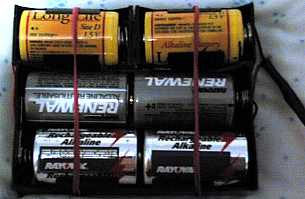
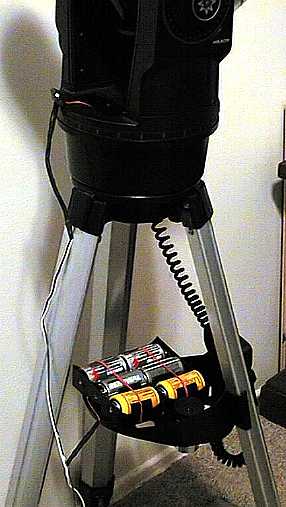
Return to the top of this page.
Go back to the Tech Tips page.
Go back to the ETX Home Page.